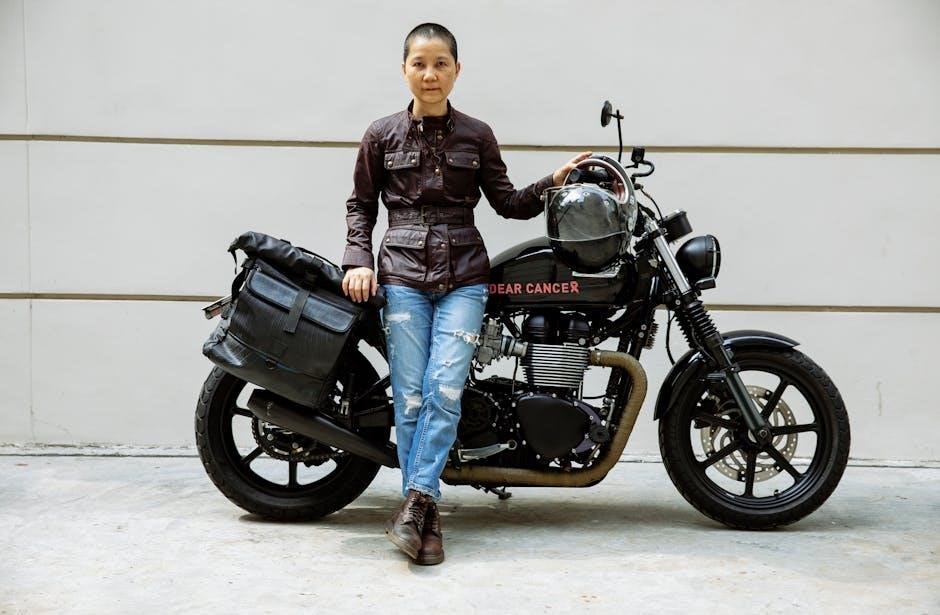Choosing the right motorbike jacket size ensures safety, comfort, and mobility. Proper fit impacts protection and ease of movement while riding. Key measurements include chest, waist, shoulders, and inseam.

Why Choosing the Right Size is Important
Choosing the right size for a motorbike jacket is crucial for safety, comfort, and performance. A well-fitting jacket ensures optimal protection, as it keeps padding and armor in correct positions. Ill-fitting jackets can compromise safety and comfort, restrict movement, or cause distractions while riding. Proper fit also enhances mobility and reduces fatigue on long rides. Different riding styles and weather conditions may require specific fits, and the jacket should accommodate additional layers if needed. Correct sizing ensures that adjustment features like cuffs and waist straps function effectively. Ultimately, the right size is essential to balance protection, comfort, and flexibility, ensuring an enjoyable and safe motorcycling experience.
Understanding Measurements for Motorbike Jackets
Accurate chest, waist, shoulder, and inseam measurements are essential for a proper fit. These measurements ensure the jacket provides optimal protection and comfort while riding.
How to Measure Your Chest
To measure your chest for a motorbike jacket, use a flexible tape measure. Wrap it around the widest part of your chest, keeping the tape level and parallel to the floor. Ensure the tape passes under your armpits and across the shoulder blades. Do not pull the tape too tight or too loose. Stand naturally with your arms slightly away from your body to get an accurate measurement. This will help determine the correct size for optimal fit and protection. Proper chest measurement ensures the jacket sits comfortably and provides adequate coverage while riding.
How to Measure Your Waist
To measure your waist for a motorbike jacket, use a flexible tape measure. Locate the narrowest part of your natural waistline, typically just above your hipbones and below your ribcage. Wrap the tape measure around this area, ensuring it is level and parallel to the floor. Keep your stance natural, with your feet shoulder-width apart and your arms relaxed at your sides. Do not pull the tape too tight or sag it excessively; This measurement is crucial for determining the jacket’s fit around your midsection, ensuring proper coverage and comfort while riding. Accurate waist measurement helps in selecting a jacket that offers optimal protection and mobility. It also ensures the armor and padding align correctly with your body.
How to Measure Your Shoulders
To measure your shoulders for a motorbike jacket, stand upright and relax your arms at your sides. Use a flexible tape measure or a piece of string to find the widest part of your shoulders. Place the tape measure across the back of your shoulders, just below the base of your neck, and align it with the top of your shoulder blades. Ensure the tape is level, parallel to the floor, and not pulled too tight. This measurement helps determine the jacket’s shoulder fit, ensuring proper alignment of armor and padding. Accurate shoulder measurement is essential for both comfort and protection, as it ensures the jacket sits correctly without restricting movement while riding; Take note of the measurement and compare it to the size chart for the best fit.
How to Measure Your Inseam
To measure your inseam for a motorbike jacket, stand upright and place your feet shoulder-width apart. Use a flexible tape measure or a piece of string to measure the length of your inner leg. Start the measurement from the crotch area (the top of your inner thigh) and extend it down to the bottom of your ankle bone. Ensure the tape measure is snug but not too tight, as this will provide the most accurate length. This measurement helps determine the jacket’s length, particularly for styles designed to reach your hips or lower back. Accurate inseam measurement ensures the jacket fits properly, providing optimal coverage and comfort while riding. Compare your measurement to the size chart to select the best fit for your body type and riding needs.
How to Read a Motorbike Jacket Size Chart
Reading a motorbike jacket size chart involves matching your body measurements to the corresponding jacket sizes. Most charts include measurements for chest, waist, shoulders, and inseam. Start by identifying your measurements from the data you collected. Locate the size that aligns with your chest measurement, as this is typically the primary determinant of jacket size. Waist and shoulder measurements should also be cross-referenced to ensure a balanced fit. Pay attention to whether the chart uses numerical sizing (e.g., 40, 42) or alphabetical sizing (e.g., S, M, L). Some charts may also include inseam lengths to determine jacket length. If you fall between sizes, consider your body type and riding style to decide whether to size up or down. Always check for specific notes or adjustments, such as stretch panels or armor, that may affect the fit. This ensures you select a jacket that offers both comfort and protection while riding.

Factors Influencing Jacket Fit
Riding posture, body type, and weather conditions significantly impact jacket fit. Riders with broader shoulders or longer torsos may need larger sizes, while layering affects snugness. Proper fit ensures comfort and mobility.
Riding Style and Jacket Fit
A rider’s style significantly influences the ideal jacket fit. For aggressive or sport riders, a snug, streamlined fit is crucial for aerodynamics and high-speed maneuverability. Touring riders may prefer a slightly looser fit for comfort during long rides. Cruiser riders often opt for relaxed fits to accommodate casual, upright postures. Commuters might prioritize versatility, balancing mobility and weather protection. Each style demands specific measurements and flexibility to ensure optimal comfort and safety. Understanding your riding style helps tailor the jacket to your needs, enhancing both performance and protection on the road.
Types of Jackets and Their Fit
Motorbike jackets come in various styles, each designed for specific riding needs. Sport jackets are slim-fit, offering aerodynamics for high-speed riding. Touring jackets provide a relaxed fit with extra pockets for long-distance comfort. Cruiser jackets are loose-fitting, ideal for upright riding postures. Adventure or dual-sport jackets combine durability with adjustable fits for versatile terrain. Each type prioritizes different features, such as armor placement, weather resistance, or storage. Understanding the jacket style that matches your riding preference ensures a balance of protection, mobility, and comfort. Proper fit varies by design, so selecting the right type is as important as measuring accurately. This ensures the jacket performs as intended, whether on the highway or off-road.
Padding and Armor Impact on Size
Padding and armor in motorbike jackets play a crucial role in both safety and fit. Jackets with built-in armor or padding may require a slightly larger size to accommodate the additional material. Areas like the shoulders, elbows, and back often have reinforced padding, which can add bulk. Riders should consider this when measuring, as the armor can make the jacket feel tighter. Removable padding offers flexibility, allowing for a more tailored fit. However, fixed armor pieces may limit size adjustments. It’s important to check the jacket’s armor placement and thickness to ensure proper mobility and comfort. Balancing protection with fit is essential for optimal performance and safety while riding.
Weather and Layering Considerations
Weather conditions and layering significantly impact motorbike jacket fit. In colder climates, riders often wear insulating layers underneath, which may require sizing up for comfort and mobility. Summer jackets are typically lighter and more fitted, reducing the need for additional layers. Waterproof and ventilated jackets may have slightly different fits due to membrane materials. When layering, consider the thickness of base layers, fleeces, or thermals, as they can restrict movement if the jacket is too tight. Adjustable cuffs, hem, and waist features help tailor the fit for varying layering needs. Ensuring the jacket accommodates seasonal layers without compromising protection or flexibility is crucial for a safe and comfortable ride year-round. Proper fit with layers ensures optimal performance and protection in all weather conditions.

Material and Thickness of Motorbike Jackets
Motorbike jackets vary in material and thickness, affecting fit and durability. Leather offers protection but may require breaking in, while synthetic materials are lighter and more flexible.
Different Materials and Their Effects on Fit

Motorbike jackets are made from various materials, each affecting fit differently. Leather jackets are durable but may require breaking in, while synthetic materials like polyester offer flexibility and a more relaxed fit. Mesh panels enhance ventilation but can feel looser due to their breathable design. High-density nylon provides structure without restricting movement. The choice of material impacts how the jacket molds to your body, with leather conforming over time and synthetic fabrics maintaining consistent shape. Riders should consider their riding style and climate when selecting materials, as thickness and flexibility vary. Proper fit ensures optimal protection and comfort, making material selection a crucial factor in choosing the right jacket size.

Thickness of Jacket and Size Implications
The thickness of a motorbike jacket significantly impacts its fit and sizing. Thicker jackets, often made of robust materials like leather or high-density nylon, provide superior protection but may feel tighter due to their sturdier construction. Thinner jackets, such as those with mesh panels or lightweight synthetic fabrics, offer more flexibility and a looser fit. Riders should consider their riding style and climate when choosing jacket thickness, as this affects comfort and mobility. A thicker jacket may require sizing up to accommodate its bulk, while a thinner jacket can fit more snugly. Proper sizing ensures the jacket doesn’t restrict movement or feel overly bulky, balancing protection and comfort effectively. Understanding the thickness and its implications helps riders select the ideal size for their needs.
Common Fit Issues and Solutions
Common fit issues include jackets being too tight, restricting movement, or too loose, compromising protection. Solutions involve adjusting cuffs, waistbands, or seeking jackets with flexible materials for better mobility.
When the Jacket is Too Tight
A jacket that is too tight can restrict movement and cause discomfort while riding. This can lead to reduced flexibility, making it difficult to maneuver the bike or reach controls. Additionally, tight jackets may impede breathing and cause chafing, especially during long rides. To address this issue, consider the following solutions:
- Opt for a jacket with adjustable cuffs and waistbands to customize the fit.
- Look for jackets made from stretchable or flexible materials that allow better mobility.
- Ensure accurate measurements by referring to the size chart and rechecking your body measurements.
- Consider a jacket with a relaxed fit or ergonomic design for improved comfort.
A well-fitting jacket is essential for both safety and riding performance, so addressing tightness is crucial for an optimal experience.
When the Jacket is Too Loose
A jacket that is too loose can compromise safety and comfort while riding. Excess fabric may flap in the wind, causing distraction and discomfort. Additionally, a loose fit can prevent protective armor from staying in place, reducing its effectiveness in the event of an impact. To resolve this issue:
- Adjust the fit using features like shoulder straps, waistbands, or cuff adjustments to snug the jacket to your body.
- Refer back to the size chart to ensure you’ve selected the correct size based on your measurements.
- Consider a tailored or slim-fit jacket if your current style is too boxy.
- Layering appropriately can also help achieve a balanced fit without sacrificing mobility or protection.
A properly fitted jacket ensures optimal safety, comfort, and performance while riding.
Adjusting for Body Type Variations
Different body types require tailored approaches to ensure a motorbike jacket fits correctly. For riders with a broader chest or shoulders, jackets with adjustable shoulder straps or expansion panels can provide a more tailored fit. Petite riders may benefit from slim-fit jackets or adjustable cuffs to prevent excess fabric. Those with longer torsos should look for jackets with extended backs or adjustable hems to ensure proper coverage. Additionally, jackets with flexible materials or stretch panels can accommodate muscular or athletic builds. Testing the jacket while wearing typical riding gear, such as a back protector, helps ensure the fit remains consistent. Adjusting for body type variations ensures optimal comfort, mobility, and protection while riding.
Breaking In a New Jacket
Breaking in a new motorbike jacket is essential for achieving optimal comfort and flexibility. Start by wearing the jacket during short rides or while performing daily activities to allow the material to mold to your body. Leather jackets, in particular, benefit from this process, as they soften and conform over time. Ensure the jacket is not too tight, as this can restrict movement and cause discomfort. For synthetic materials, the break-in period is typically shorter, but proper fitting is still crucial. Consider using leather conditioners for leather jackets to enhance suppleness. Over time, the jacket will adapt to your body, providing a more personalized fit. Patience is key, as the break-in process ensures the jacket performs well during rides and maintains its protective qualities.

Adjustment Features in Motorbike Jackets

Adjustable cuffs, waistbands, and shoulders ensure a tailored fit. Zippered vents and elastic panels enhance flexibility. These features optimize comfort and mobility while maintaining protective functionality during rides.
Adjustable Cuffs and Waist
Adjustable cuffs and waist features in motorbike jackets allow for a customized fit, ensuring comfort and protection. These adjustments enable riders to tailor the jacket to their body shape, preventing drafts and enhancing mobility. The cuffs, often secured with Velcro or zippers, can be tightened or loosened to accommodate gloves, while the waist adjustment provides a snug fit, reducing bulk. These features are particularly useful for layering, as they help maintain a secure fit even with additional clothing underneath. Properly adjusted cuffs and waist improve overall safety by ensuring pads and armor stay in place. Riders can fine-tune these elements to suit their riding style, whether cruising or racing, ensuring optimal performance and comfort on the road. Always consult the size chart and try the jacket on to ensure the best fit with these adjustable elements.
Shoulder and Elbow Adjustments
Shoulder and elbow adjustments in motorbike jackets are crucial for achieving a precise fit and optimal protection. These features, often in the form of adjustable straps or buckles, allow riders to customize the jacket’s fit around the shoulders and elbows. Properly fitted shoulders ensure that armor stays in place, providing maximum protection during impacts. Elbow adjustments prevent the armor from shifting, maintaining coverage even when bending or moving. These adjustments also enhance comfort by allowing a full range of motion, which is essential for various riding styles. Riders can tighten or loosen these points to accommodate their body type or layering needs. Ensuring the shoulders and elbows fit snugly but comfortably is vital for both safety and performance while riding. Always refer to the size chart and test the fit to make the most of these adjustable features.
Zipper and Fastening Mechanisms
Zipper and fastening mechanisms are essential components of motorbike jackets, ensuring a secure and customizable fit. High-quality zippers, often waterproof or reinforced, provide durability and reliability, while adjustable fasteners like buckles or Velcro straps allow riders to fine-tune the jacket’s fit. These mechanisms are crucial for maintaining the jacket’s structural integrity and protection during rides. Secure fastening prevents Wind penetration and ensures armor stays in place. Easy-to-use zippers and straps enable quick adjustments, enhancing comfort and practicality. Durable materials and robust designs ensure these mechanisms withstand rough conditions. Properly functioning zippers and fasteners are vital for both safety and convenience, making them a key consideration when selecting a motorbike jacket. Always test these features to ensure they meet your riding needs and preferences.
Selecting the right motorbike jacket size is crucial for safety, comfort, and performance. Proper fit ensures optimal protection and mobility while riding. Always measure carefully, considering chest, waist, shoulders, and inseam. Refer to size charts and adjust for body type, riding style, and layering needs; Pay attention to material thickness and padding, as these can affect fit. If the jacket is too tight or loose, consider adjustments or a different size. Break in new jackets gradually to ensure comfort. Test zippers, fasteners, and adjustable features to ensure functionality. Prioritize durability and weather-appropriate materials. Finally, try jackets with your gear to confirm fit and protection. By following these tips, you can find a motorbike jacket that meets your needs and enhances your riding experience.
